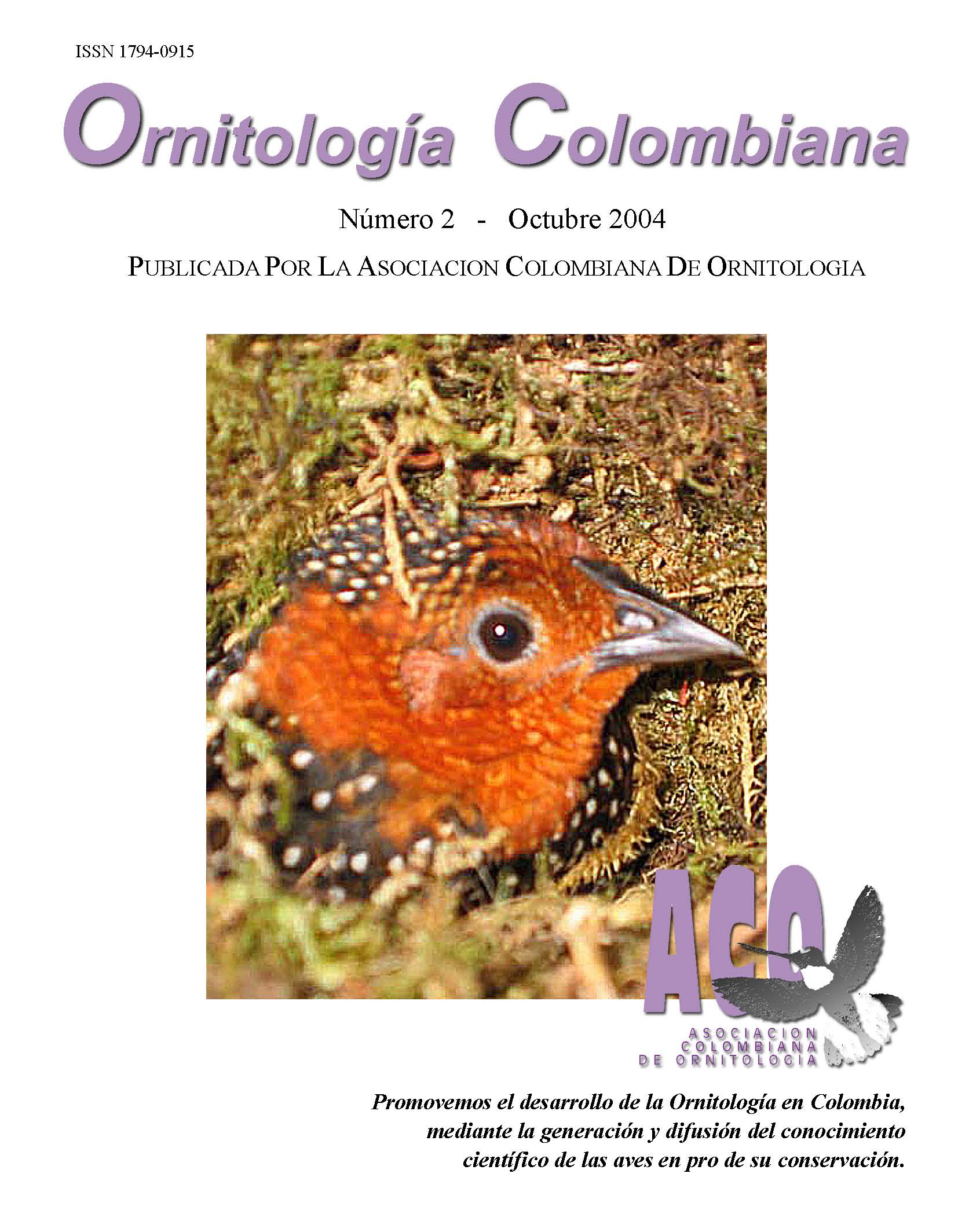Why we should not liberate confiscated wild animals
Why we should not liberate confiscated wild animals
DOI:
https://doi.org/10.59517/oc.e40Abstract
No disponible en este tipo de documento
Downloads
References
Adams, L. W., J. Hadidian & V. Flyger. 2004. Movement and mortality of translocated urban-suburban grey squirrels.Animal Welfare 13: 45-50.
Anónimo. 1999. Centros regionales para el manejo de especímenes de fauna silvestre decomisados: elementos técnicos para su diseño y construcción. Protocolos para el manejo y disposición de animales post decomiso. Ministerio del Medio Ambiente, Bogotá, Colombia.
Banks, P. B., K. Norrdahl & E. Korpimaki. 2002. Mobility decisions and the predation risks of reintroduction. Biological Conservation 103:133-138.
Barragán, K. B. 2003. Destino de los animales silvestres en cautiverio: rehabilitación vs. eutanasia. Boetín del Grupo de Estudio de Animales Silvestres Volumen 5 (2).
Borrero, L. P. 1998. Rehabilitación de aves decomisadas. Pág. 19 en: Resúmenes del XI Encuentro Nacional de Ornitólogos. Fundación Calidris. Buga, Valle del Cauca, Colombia.
Callicott, J. B. 1990. Whither conservation ethics? Conservation Biology 11: 32-40.
Callicott, J. B., L. B. Crowder & K. Mumford. 1999. Current normative concepts in conservation. Conservation Biology 13: 22-35.
Daszak, P., A. A. Cunningham & A. D. Hyatt. 2000. Emerging infectious diseases of wildlife: threats to biodiversity and human health. Science 287: 443-449.
Deem, S. L., W. B. Karesh & W. Weisman. 2001. Putting theory into practice: wildlife health and conservation. Conservation Biology 15: 1224-1233.
Dunham, K. 1997. Population growth of mountain gazelles Gazella gazella reintroduced to central Arabia. Biological Conservation 81: 205-214.
Fischer, J. & D. B. Lindenmayer. 2000. An assessment of the published results of animal relocations. Biological Conservation 96: 1-11.
Gaydos, J. K., W. R. Davidson, F. Elvinger, D. G. Mead, E. W. Howerth & D. E. Stallknecht. 2002. Innate resistance to epizootic hemorrhagic disease in white-tailed deer. Journal of Wildlife Diseases 38: 713-719.
Hedrick, P. W. 1995. Gene flow and genetic restoration: the Florida panther as a case study. Conservation Biology 9:996-1007.
Hedrick, P. W. 2004. Recent developments in conservation genetics. Forest Ecology and Management 197: 3-19.
Hughes, J., K. Goudkamp, D. Hurwood, M. Hancock & S.Bunn. 2003. Translocation causes extinction of a local population of the freshwater shrimp Paratya australiensis. Conservation Biology 17: 1007-1012.
Iucn 2002. IUCN Guidelines for the Placement of Confiscated Animals. Species Survival Commission of the IUCN – The World Conservation Union, Gland, Suiza.
Komdeur, J. 1994. Conserving the Seychelles warbler Acrocephalus sechellensis by translocation from Cousin Island to the islands of Aride and Cousine. Biological Conservation 76: 143-152.
Komdeur, J. 2002. Daughters on request: about helpers and egg sexes in the Seychelles warbler. Proceedings of the Royal Society of London B 270: 1471-2954.
Larkin, J. L., K. J. Alexy, D. C. Bolin, D. S. Maehr, J. J. Cox, M. W. Wichrowski & N. W. Seward. 2003.Meningeal worm in a reintroduced elk population in Kentucky. Journal of Wildlife Diseases 39: 588-592.
Letty, J., S. Marchandeau, F. Reitz, J. Clobert & F. Sarrazin. 2002. Survival and movements of translocated wild rabbits (Oryctolagus cuniculus). Game and Wildlife Science 19: 1-23.
Mills, M. G. L & M. L. Gorman. 1997. Factors affecting the density and distribution of wild dogs in the Kruger National Park. Conservation Biology 11: 1397-1406.
Moritz, C. 1999. Conservation units and translocations: strategies for conserving evolutionary processes. Hereditas 130: 217–228.
Pimentel, D. 1968. Population regulation and genetic feedback. Science 159:1432-1437.
Regan, T. 2003. Animal rights, human wrongs: an introduction to moral philosophy. Rowman and LittleField Publishers, Lanham, MD, Estados Unidos.
Richards, J. D. & J. Short. 2003. Reintroduction and establishment of the western barred bandicoot Perameles bougainville (Marsupialia: Peramelidae) at Shark Bay, Western Australia. Biological Conservation 109:181-195.
Ricklefs, R. E. & S. M. Fallon. 2002. Diversification andhost switching in avian malaria parasites. Proceedings of the Royal Society of London B 269: 885-892.
Ripple, W. J., E. J. Larsen, R. A. Renkin & D. W. Smith. 2001. Trophic cascades among wolves, elk and aspen on Yellowstone National Park’s northern range. Biological Conservation 102: 227-234.
Ripple, W. J. & R. L. Beschta. 2003. Wolf reintroduction, predation risk, and cottonwood recovery in Yellowstone National Park. Forest Ecology and Management 184:299-313.
Singer, P. 1990. Animal liberation. Segunda edición. Avon Books, Nueva York, Estados Unidos.
Sociedad Antioqueña De Ornitología. 1999. Aves del Valle de Aburrá. Área Metropolitana. Ed. Colina. Medellín.
Stiles, F. G. & P. Caycedo. 2002. A new subspecies of Apolinar’s Wren (Cistothorus apolinari, Aves: Troglodytidae), an endangered Colombian endemic. Caldasia 24: 191-199.
Suárez, C. E., E. M. Gamboa, P. Claver & F. Nassar-Montoya. 2001. Survival and adaptation of a released group of confiscated capuchin monkeys. Animal Welfare 10: 191-203.
Templeton, A.R. 1986. Coadaptation and outbreeding depression. Págs. 105-116 en: M.E. Soulé (ed.). Conservation biology: the science of scarcity and diversity. Sinauer Associates, Sunderland, MA, Estados Unidos.
Tutin, C. E. G., M. Ancrenaz, J. Paredes, M. Vacher-Vallas, C. Vidal, B. Goossens, M. W. Bruford & A. Jamart. 2001. Conservation biology framework for the release of wildborn orphaned chimpanzees into the Conkouati Reserve, Congo. Conservation Biology 15:1247-1257.
Van Riper, C., Iii, S. G. Van Riper, M. L. Goff & M.Laird. 1986. Epizootiology and ecological significance of malaria in Hawaiian land birds. Ecological Monographs 56: 327-344.
Van Riper, C. Iii, S. G. Van Riper & W. Hansen. 2002. The epizootiology and ecological significance of avian pox in Hawaii. Auk 119: 929-942.
Wolf, C. M., T. Garland, Jr & B. Griffith. 1998. Predictors of avian and mammalian translocation success: reanalysis with phylogenetically independent contrasts. Biological Conservation 86:243-255.
Downloads
Published
Issue
Section
License

This work is licensed under a Creative Commons Attribution-NonCommercial 4.0 International License.





